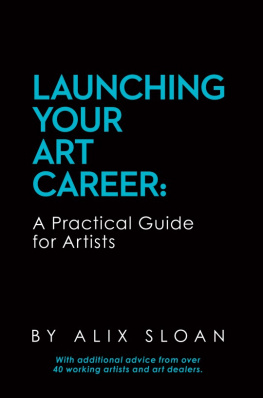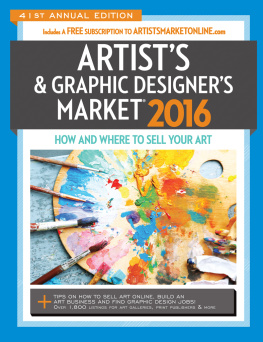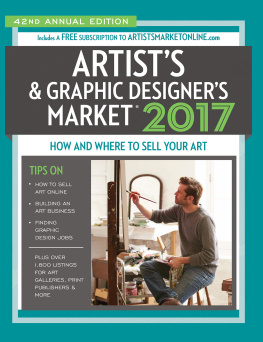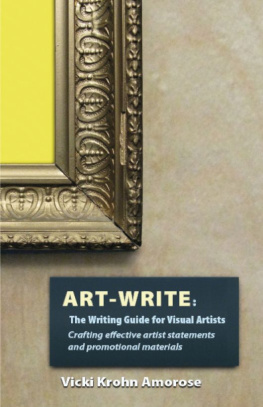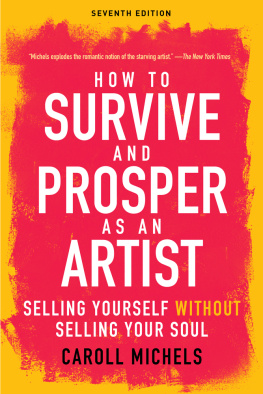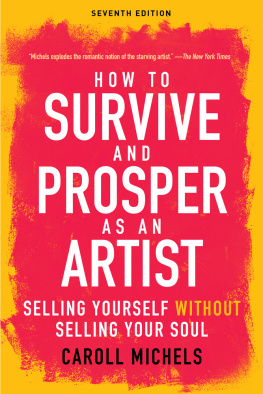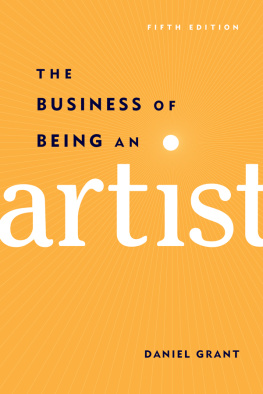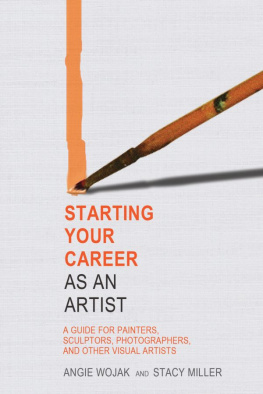LAUNCHING YOUR ARTCAREER:
A Practical Guide for Artists
By Alix Sloan
Launching Your Art Career: A Practical Guidefor Artists
Published by Alix Sloan at Smashwords
This e-book is licensed for your personalenjoyment only. This e-book may not be re-sold or given away toother people. If you would like to share this book with anotherperson, please purchase an additional copy for each recipient. Ifyoure reading this book and did not purchase it, or it was notpurchased for your use only, then please return to Smashwords.comand purchase your own copy. Thank you for respecting the hard workof this author.
Although the author has made every effort toensure that the information in this book was correct at press time,the author does not assume and hereby disclaims any liability toany party for any loss, damage, or disruption caused by errors oromissions, whether such errors or omissions result from negligence,accident, or any other cause.
Cover Design: Shane Eichacker
Editor: Amy Eyrie
Copyright 2015 Alix Sloan
All rights reserved.
ISBN: 1514628449
ISBN-13: 978-1514628447
For Katherine Chapin.
The only thing she appreciated more than acompelling work of art,
was the artist who created it.
Contents
PART ONE
Getting Started
CHAPTER ONE
What To Expect From ThisBook
After two decades in the art world as acurator, consultant, private dealer and gallerist, Ive seenhundreds of careers skyrocket, plummet, stall, ebb and flow. I cantell you with absolute confidence that there is no secrethandshake, no magical pixie dust, no certified road map to success.I wont reveal any of those shortcuts here because they dontexist. But if you are making art you believe in, and willing towork hard and stick with it, this guide does contain advice andtools that will help you:
Understand and navigate the art world.
Find and create opportunities.
Exhibit and sell your work.
Be prepared and professional.
Build and advance your career.
One of the challenges I find many artistsface is accepting that the art world is a business. I know that canbe a depressing thought. We dont have to dwell on it. But bychoosing to exhibit and sell your work you are agreeing toparticipate in a system that is, at the end of the day, anindustry. You are your own business. If that is something youstruggle with, consider this How many people get the chance to dowhat they love and get paid for it? Far too few. You have anopportunity to do what you love, share it with others, andhopefully make a living. Thats something to be excited about, notput off by.
This book is broken down into eight sections.After this intro, youll find a list of basic terms. Give those aglance, just to make sure youre clear on the terminology Ill beusing.
Sections two through six take you from moregeneral concepts like setting goals and networking, to morepractical information about creating effective support materialsand running your studio, to information about tackling thechallenges of getting your work out there, surviving and thriving.Youll get the most out of those sections if you read them inorder, as they start with laying a foundation and then build fromthere.
Because none of us has all of the answers,and everyone has a different experience, I reached out to some ofmy colleagues working artists, many of whom are well-respectedteachers, and also art dealers who work with emerging to mid-careerartists and asked them to each share one piece of advice withyou. Youll find their varied and inspiring contributions insection seven.
In the final section, I wrap things up with afew reminders, a few requests and a list of additional resourcesyou can access online.
At the very end of this guide youll findmore information about me if youre curious. The short version is,Ive been honored, inspired and educated by working with hundredsof artists throughout my career. I know that everyone who readsthis book will be approaching building their career from adifferent place. But my hope is that by sharing what Ive observedand learned, I can provide you with the information, motivation andinspiration you need to start, restart or continue your life as aworking artist, with the best possible experience and results.
CHAPTER TWO
Some Basic Terms
As you interact with larger and largergalleries, there will be more and more people involved in itsday-to-day operations. For the purposes of this book, heres ashort list of people and terms youre likely to run into rightaway:
Gallerist A gallerist is the person whoowns or runs a commercial gallery. Its common at a small tomedium-sized gallery for the gallerist or owner to also be thegallery director. Often these terms are used interchangeably.
Gallery Director This person makesdecisions about exhibitions, looks for new artists, engages withthe art world, collectors, and makes sales. The gallery directorwill most likely be your primary contact at a gallery.
Gallery Manager A gallery managerusually runs the more practical day-to-day aspects of the gallery,but is not involved in curating shows or making decisions about whoexhibits at the gallery.
Art Handler This person is employed fulltime or freelance by a gallery or art handling company. Arthandlers carefully and professionally pack, install, and transportyour art.
Curator This is the person who comes upwith the idea for a show and puts it together. In a traditionalgallery setting, this may be the gallerist or director. Sometimes agallery will bring in an outside curator to organize a specialexhibition. Nonprofit spaces and arts organizations use outsidecurators regularly.
Juror In the case of an open call orjuried show, this is the person who looks through submissions andpicks the art for a show. This person is also sometimes thecurator.
Consultant This is a very loose term forsomeone who gets paid in some way to have an opinion about art.Many private and corporate collectors employ consultants to helpthem select and purchase art.
Art Dealer This is probably the mostgeneral term for someone who sells art. Gallerists are art dealers.Consultants who sell work are art dealers. If an interior designersells a client a piece of your art, they are acting as your artdealer in that moment. I use dealer and gallerist prettyinterchangeably throughout the book, but mostly gallerist becauseits the term Im most accustomed to using.
Commercial Gallery By commercial galleryI mean a gallery that exhibits and sells artwork, not a nonprofitspace. There is an extraordinarily broad range of galleries withinthis category. You can usually get a pretty good idea of thegeneral vibe of a space by researching what they show, where theyare, how they market and present the gallery and exhibitions, andgeneral word of mouth.
Nonprofit Galleries, Centers &Organizations A nonprofit raises money from various sourcesincluding sales, fundraisers and donations. It then puts that moneyback into funding its programs. As with commercial galleries, youwill come across a wide range of professionalism and cachet withinthis category.
Art Fairs An art fair, for the purposesof this book, is an organized event where galleries exhibit andsell art by the artists with whom they work. There are manydifferent types and levels of art fairs. They are held in citiesand countries all over the world. Galleries apply, and pay, toparticipate in these curated fairs.
Community Art Fairs & Festivals These are organized events where artists or artistsrepresentatives can sell art. They are often held in conjunctionwith other local events such as a wine, food or music festival.
PART TWO
Preparing For Success
CHAPTER THREE
Setting Goals
This section will help you lay thefoundation for launching, relaunching or advancing your art career.I know there is a temptation to jump ahead and dive into theinformation about showing and selling your work. But I reallybelieve that the steps in this section are just as important.Artists who make smart decisions based on their goals, maintain ahealthy community and network, and take the time to createexcellent support materials, are the most successful.
Next page
